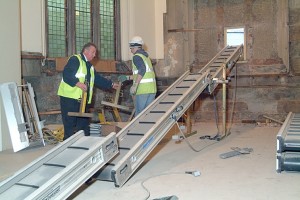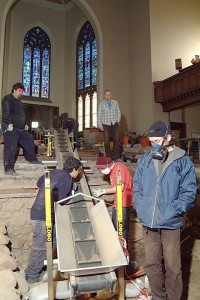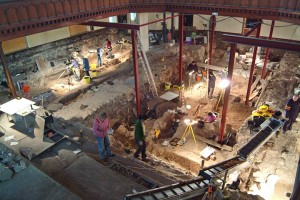By its very nature, an archaeological dig produces a lot of ‘waste’ material. The practical problem is what to do with it. One option is to store it nearby, however, this was not an option in the dig in the former East Kirk of St Nicholas for two reasons. One was simply that the amount of spoil would be too great to be stored in the Kirkyard where public access had to be maintained and where there were many historic memorials. Additionally the space created by the dig was to be used as a new level in the proposed development of the building. It was, therefore, going to be necessary to remove the spoil using skips to landfill. That in itself created a problem, because the skip could not be accommodated in the Kirkyard. However, a location was available at the top of Correction Wynd. This was at a lower level than the access to the dig site with public footpaths and stairways in between.

The solution was to open part of the wall high up on the east end of the building where there had been a larger window than the present one and then have one of those plastic bucket chutes down to the waiting skip. Many people walking on St Nicholas Street were startled by the rumbling noise produced when material went down! There was also an internal logistic problem to be overcome – how to get the spoil up to the height of the opening from the dig which would be going down to a depth of about 5 m (15 feet) lower than the opening. The answer was to use a small sectional conveyor belt system. The first photograph shows the initial steps erecting this inside the apse area of the former church. This shows the opening created in the wall and the ‘delivery’ section in place, with more sections being erected.

The second photograph shows it completed (although it could be moved, shortened or extended as necessary) with the ‘receiving end’ nearest the camera. Its method of working is fairly obvious, as the baffles on the conveyor belt caught the spoil and moved it up to the end of the section where it dropped into the next section and so on, until is went out into the chute. It worked very efficiently. Already on this photograph the conveyor is extending down a few feet below the original floor level.

The final photograph is a more general view of the dig but shows the conveyor in the lower right extending well into the dig area. The coloured plastic trugs at the side are full of spoil waiting to be loaded (it was not left running all the time!). As the dig progressed, the conveyor was moved to the opposite side, to the centre and also extended downwards as material was removed.
Problem solved!!
(The photographs are copyright Aberdeen Art Gallery & Museums Collections and are used with permission).